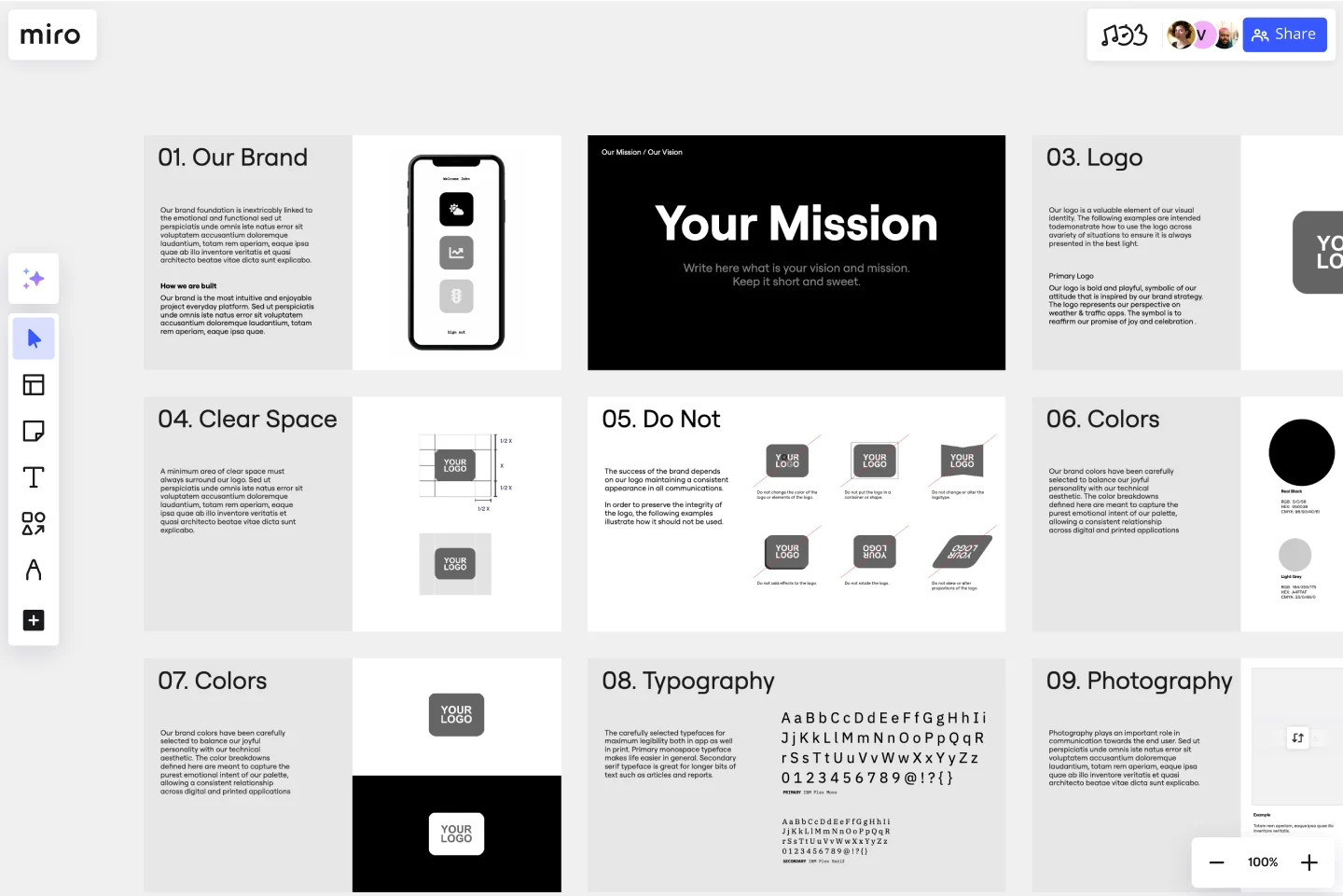Brand Guidelines Template
Identify and communicate your brand’s unique visual style and personality.
About the Brand Guidelines Template
When you think of your favorite companies, what do they have in common? For most of us, our favorite companies are defined by winning brands. The best brands are unique and instantly recognizable. They have a clear voice that informs the look and feel of their website, products, and services, marketing copy, and even how problems are solved. But brands don’t appear out of thin air.
Every great brand starts with documenting its unique brand guidelines to ensure consistency across the entire organization. These guidelines help flesh out the components that give your business its unique character. Brand guidelines should be flexible so your designers can have room to play but rigid enough to make your brand easily recognizable. That's where Miro's brand guidelines template comes in handy.
When to use the brand guidelines template
There’s never a wrong time to figure out your brand guidelines. For new businesses, brand guidelines are crucial to ensure consistency, establish trust, and foster brand recognition.
But not only new businesses can benefit from established brand guidelines. Treat them like a living document, and revisit your brand guidelines any time your brand needs refreshing: when you’re pushing into a new market, rebranding the organization, growing your business, or pivoting your product offerings.
Create your own brand guidelines
Making your own brand guidelines is easy using our simple template. Get started by selecting the brand guidelines template, then take the following steps to make one of your own.
Articulate your brand story and positioning statements. Your brand story is the narrative stream that runs through all of your marketing materials. It helps your customers connect with your brand by taking them through a journey: how you got here, what problem your brand is solving, what motivates you, and what you hope to achieve.
Connect with your customers. Customers respond to brands on an emotional level. What emotions do you want your customers to feel when they interact with your brand? Does your brand inspire loyalty? Creativity? Excitement?
Study your competitors. What do their brands look like? Dig into their voice and tone; how they present their brand; and what their products, services, websites, and marketing materials look like. Your goal here isn’t to copy competitors but to keep in mind that potential customers will be consistently comparing you to similar businesses and seeing how you measure up.
Define your brand personality. Think of your brand as a person. What are they like? How would you describe them to your friends? This brand personality will permeate everything you create. Once you nail it down, you can choose colors, fonts, photos, or other visual elements that align with your personality. Miro makes it easy to collaborate on your brand’s visual characteristics. Share graphics, talk through ideas, and iterate as a team.
Get started with this template right now.
Content Strategy Template
Works best for:
Strategic Planning
Bring consistency across communication channels and develop killer content strategies with this Content Strategy Template. Designed to plan and deliver high-impact content, use this tool to collaborate faster and better.
Communications Plan Template
Works best for:
Marketing, Project Management, Project Planning
You saw the opportunity. You developed the product. Now comes an important step: Find your audience and speak to them in a way that’s clear, memorable, and inspiring. You need a communications plan—a strategy for controlling your narrative at every stage of your business—and this template will help you create a good one. No need to build a new strategy every time you have something to communicate. Here, you can simplify the process, streamline your messaging, and empower you to communicate in ways that grow with your business.
Spider Diagram Template
Works best for:
Diagramming, Mapping
Perfect for brainstorming sessions, project planning, or simply organizing thoughts, the Spider Diagram Template allows you to create 'legs' branching out from a central idea, representing related topics or subtopics.
Venn Diagram Practical Applications
Works best for:
Venn Diagram
The Venn Diagram for Practical Applications template helps you apply Venn diagrams to real-world scenarios. Use this template to solve problems, identify relationships, and make decisions based on clear visual analysis. It's perfect for practical tasks such as project planning, resource allocation, and strategic decision-making. This tool is ideal for business professionals, educators, and anyone looking to apply theoretical concepts to practical situations.
Product / Market Fit Canvas Template
Works best for:
Market Research, Strategic Planning, Product Management
The product/market fit canvas template is used to help product teams meet customer and market needs with their product design. This template looks at a product in two dimensions: first, how the product fits user needs, and second, how the fully designed product fits within the market landscape. This combined metric understands a product holistically from the way customers use and desire a product, to the market demand. By comparing customer and product qualities side by side, users should better understand their product space and key metrics.
